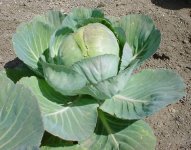kale (white) - brassica oleracea l.
The botanical characteristics.
Cruciferous. Biennial plant. Leaves are bare, upper - sessile, lower - petiolate. The flowers are pale yellow, inconspicuous. It flowers in May and June, fruits ripen in June and July. There are many varieties of cabbage.
Fruit Cabbage - pod.
Spread. Cultivated as a vegetable plant in most parts of Russia, in the open field and in greenhouses.
Used parts of the plant.
The leaves, roots, stalks, seeds.
Composition of cabbage well studied. Leaves contain vitamins (A, B, C, carotene, folic, pantothenic acid), potassium salts, phosphorous, calcium, trace elements, nitrogenous compounds (1.8%), fat (0.18%), sugar (1.92% ), nitrogen-free substance (3.13%), cellulose (1.65%), 1.18% ash and 90% water.
Application.
In folk medicine, the West and East cabbage has long been used for various diseases. Cabbage juice is prescribed for gastritis and gastric ulcer and duodenal ulcer, ulcerative colitis, as well as pulmonary tuberculosis (mixed with honey), liver diseases. Roots and stalks of cabbage considered an antitumor agent. Seed Broth use for gout, pain in the joints as antihelminthic and diuretic.
Feasibility of application in medical practice cabbage confirmed after it has been experimentally proved its antiulcer properties. Antiulcer cabbage factor called vitamin U - from the Latin word ulcus - ulcer. Application of this vitamin in gastroenterological patients was less effective than the action of fresh cabbage juice.
Traditional medicine recommends fresh cabbage leaves are applied to purulent wounds and ulcers, to breast with mastitis.
Cabbage leaves are also used in abscesses and other inflammatory diseases of the skin, burns.
The information contained in the Fiber cabbage improves motor function of the intestine, it has a positive effect on its microflora. The presence in the tissue of B vitamins normalizes fat metabolism, promotes the excretion of excess cholesterol, inhibits the development of atherosclerotic plaques in the walls of the aorta and blood vessels of the heart, that is, helps the treatment and prevention of atherosclerosis.
Cabbage - one of the most valuable food. Fresh salad can saturate the demand for ascorbic acid and other vitamins year round. Well preserved vitamin C sauerkraut. Co-fermentation of cabbage with carrots, carrots and beets significantly enriches our winter table.
In folk medicine, sauerkraut juice is used as a vitamin and tonic drink that improves appetite and digestion.
Along with white cabbage are grown and available for the use of other species: of red, cauliflower, Brussels sprouts, kohlrabi. According to the content of vitamin C, they are superior to white cabbage, also contain vitamin the U, a small amount of vitamin A, B vitamins and other nutrients.
Contraindications. Not all are well tolerated cabbage and cabbage juice. Sometimes it causes flatulence and diarrhea.
Preparation.
Freshly prepared juice: Cabbage take 3 times a day for 20-40 minutes before eating (from 1/2 cup, then you can increase the dose to glass).
Pharmacy preparation: cabbage juice dry. Take 1 teaspoon (dissolved in 1/2 cup water) 3-4 times a day for 1 hour before meals. The course of treatment for 3-4 weeks. After 3-6 months of treatment can be repeated. Producing in 12 g packages



Comments
Commenting, keep in mind that the content and the tone of your messages can hurt the feelings of real people, show respect and tolerance to his interlocutors, even if you do not share their opinion, your behavior in terms of freedom of speech and anonymity offered by the Internet, is changing not only virtual, but real world. All comments are hidden from the index, spam control.